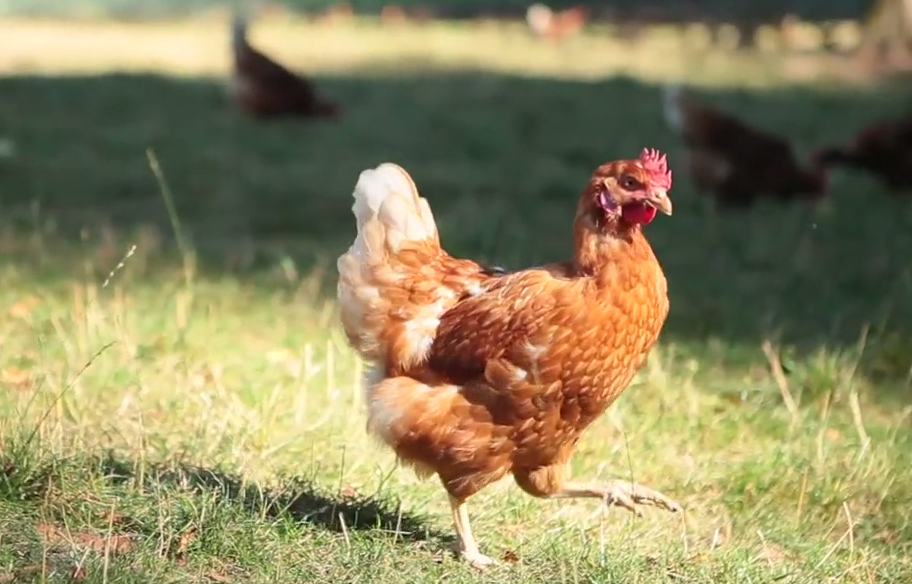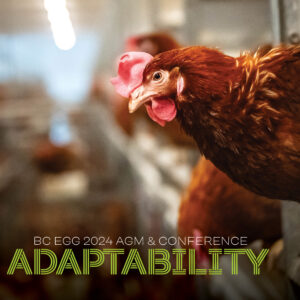Think Eggs
Eggnog Christmas Countdown
This year we’re celebrating the season with a collection of recipes showcasing our favourite holiday beverage: eggnog! We’ve got over…

ANN HUI
CHILLIWACK, B.C. The Globe and Mail
In the social-media-fuelled world of ethical eating, feelings often trump facts, and buzzy terms like ‘free-range’ may not mean what you think. Ann Hui reports.
Last September, the world’s biggest burger chain announced that it wants the 120 million eggs used each year in Egg McMuffins and other breakfast items in Canada to come exclusively from hens not confined to a cage.
The news came as a surprise not only to competitors of McDonald’s but to some who work for the company, too. It also had a cascading effect. In the months since, almost every major fast-food chain in North America has made a similar pledge to go cage-free.
In October, it was Starbucks. In December, Subway. In January, Wendy’s. Even Tim Hortons followed suit: Back in 2012, it had vowed to source more eggs from hens in “furnished cages,” which are bigger and nicer than the infamous “battery” type used for 90 per cent of the 40 million cartons of eggs produced in Canada every year. But then Tims changed owners – and its mind. In February, its parent company, which also owns Burger King, announced that both would go entirely cage-free.
What was behind the fight for feathered freedom? The short answer: public opinion and pressure. With the power of social media and the Internet, activists and animal-rights groups have gained unprecedented influence in shaping peoples’ perceptions and decisions of what to eat. And the food industry has taken notice.
A&W Canada, too, has abandoned its pledge to use eggs from furnished cages – but only after being subjected to an extensive campaign. Like those other fast-food companies, it will move away from cages of any kind, no matter their size or amenities.
And yet, the theory behind the public pressure is that chickens, and all the animals we eat, deserve a better life – and that the best of all possible worlds for them would be one without cages.
Which may not be true.
‘IT WAS A MARKETING DECISION’
The day before McDonald’s made its announcement, the company called Temple Grandin.
The petite 60-something with curly grey hair has been a household name ever since the airing of the award-winning eponymous 2010 biopic starring Claire Danes. As well as being an icon in the world of autism – a condition she lives with – Dr. Grandin is the world’s most influential expert on animal welfare.
Since teaming up with McDonald’s back in 1997, she has helped to put in place policies to reduce anxiety and stress in the lives of creatures destined to become the hamburgers and Chicken McNuggets served to tens of millions of customers around the world each day. The company has even featured her in promotional materials to tout its advancements in animal welfare.
Temple Grandin, shown in 2009, has written extensively about how to understand animals’ emotions.
Her modus operandi is practicality – presenting McDonald’s and other companies with specific, implementable recommendations, such as a checklist of welfare indicators: Are animals slipping and falling? Are they being poked in sensitive areas? And her signature innovations – such as designing curved corrals for cattle to walk in as they’re led to slaughter, to reduce their ability to see what’s coming – can be found in processing plants across North America.
So, it wasn’t surprising for her to receive the call from McDonald’s last September – but this time she wasn’t being asked for an opinion. “Our science-based welfare committee did not make that decision” to go cage-free, she explained earlier this year while at the University of Guelph, to speak at a conference. “It was a marketing decision.”
Rather than science alone, says Jill Manata, the company’s vice-president of global public affairs, McDonald’s had based its move on “our values as a company, what our customers are expecting” and “the marketplace.” Still, she says the company did consult its animal-welfare council, but just the experts specifically focused on poultry; Dr. Grandin focuses mostly on cattle.
Now more than ever, what customers are expecting is for giant food companies like McDonald’s to take steps to ensure the humane treatment of animals. The rise of social media and the cellphone camera has allowed activists for such groups as People for the Ethical Treatment of Animals (PETA) and Mercy for Animals to record undercover images depicting horrendous abuse – animals being punched, kicked and worse – and then broadcast those images to millions.
The costs of such campaigns has been real. Companies depicted allegedly abusing animals – such as Chilliwack Cattle Sales, one of Canada’s largest dairy farms, charged last month after being featured in a 2014 Mercy For Animals video – have found themselves boycotted, and dropped by major buyers. Just about every large chain has been vilified in campaigns bearing such names as “Kentucky Fried Cruelty” and “McCruelty,” despite the advice those companies have gotten from the likes of Dr. Grandin. (In McCruelty, mascot Ronald McDonald is rebranded Evil Ronald, a maniac who slaughters chickens with a blood-drenched meat cleaver.)
The egg industry in particular has felt the heat, especially its practice of housing chickens in wire battery cages. Activists have broadcast images of crowded, emaciated birds, each with space the size of a sheet of paper and barely able to flap its wings. Among the industry’s customers, McDonald’s has been singled out for particular censure, including with an anti-battery-cage campaign that received over 120,000 signatures in Canada, and that has won support from such celebrities as Ryan Gosling and Bryan Adams.
In some cases, the food industry’s attempts to address concerns have led to awkward, or mixed, results. Just this week, Earls, the Vancouver-based restaurant chain, announced that its move to using “certified humane” beef means it will no longer source meat from Alberta farmers. Social media lit up with calls for a boycott.
In the wake of such criticisms, many companies have turned to experts like Dr. Grandin to help them understand animal welfare better: what motivates animals; what behaviours come naturally to them; and what causes them fear, stress or pain.
Above all, the scientists have tried to help the companies distinguish between feelings – the visceral, emotional response that the public has to animals – and the facts. But in the move toward cage-free eggs, feelings appear to trump the facts.
Dr. Grandin, looking very much the livestock expert in her black Western shirt embroidered with red roses (and her name) likens the situation to Internet-based computing. “Where does a movie come from if you get it off of Netflix?” she asks. “The cloud is not a cloud. Somebody has to make that all work.”
The same is true with food: Most urbanites know little about food production, she says. They pick up their meat neatly sliced and packaged at the grocery store, or use an app to have fully prepared meals land on their doorstep within minutes.
This lack of knowledge, she says, is exploited by all those who have a stake in telling people how to eat – producers, companies and activists alike. And instead of getting their information from credible sources, people increasingly make snap judgments based on information from the Internet, images from social media – and their emotions.
In some cases, public pressure has led to positive steps. McDonald’s now requires its suppliers to undergo regular third-party audits of how they treat animals.
And from 2010 to 2013, the fast-food chain helped to finance, through the Coalition of Sustainable Egg Supply, a groundbreaking study on hen housing. Conducted by 18 leading researchers at Michigan State University, the University of California, Iowa State and the U.S. Department of Agriculture, it compared the impact of the three most-used housing systems:
Standard battery cages, in which four to eight birds each have about 67 square inches (the size of a magazine cover) of living space; “Furnished” or “enriched” cages, which have about twice as much space, plus separate areas for nesting and perching; Cage-free, often known as free-run, in which birds are loose in an open barn, but not allowed outside (free range means the birds get to go outside when the weather co-operates).
All three systems were rated based on a variety of factors, including food safety, animal health and well-being, environment, worker health and safety, and food affordability.
The results present a much more complicated picture than the simple idea that cage-free is always better.
“There’s a downside to taking birds out of their cages,” says Tina Widowski, the Egg Farmers of Canada research chair in poultry welfare at the University of Guelph, “in that they’re free, but they’re also free to get hurt and free to get in trouble.”
There are pros and cons to all three systems.
When it came to freedom and the ability for birds to express natural behaviours, a cage-free environment, not surprisingly, provides the most benefits. And yet, contrary to popular opinion, it also has the greatest negative impact in every category. On animal health and well-being, the environment, worker health and safety, and food affordability, cage-free had the most severe consequences.
For example, 12 per cent of cage-free hens die prematurely – about double the rate of those in cage systems – often from issues that cages were originally introduced to prevent: bone injuries, excessive pecking – and cannibalism.
The last of those is caused by a variety of factors, but “once cannibalization starts, it spreads throughout the flock, because birds copy each other’s behaviour,” says Joy Mench, a professor of animal science at UC Davis, and a lead researcher on the study. “If a bird is in a conventional [battery cage] system and there’s only six birds, it doesn’t go very far. But if it’s in an aviary where you have lots of birds, you can get this very rapid spread of cannibalization.”
The study also raised concerns about hygiene, air quality and health, of both hens and workers. With cages, manure drops through the wire floor, collected safely away from both the bird and eggs. But when birds are free to roam, it can be difficult to control where the eggs and manure end up. Meanwhile, material for dust-bathing – bits of straw or sawdust that the birds roll around in to “clean” themselves of parasites – is also kicked up into the air, resulting in dust levels between eight and 10 times that of caged systems.
In most categories, problems with furnished cages were less severe than they were with either battery or cage-free systems.
Asked what she would have advised McDonald’s on eggs, Dr. Grandin says: “When I wrote my book, Animals Make Us Human … I thought, for large-scale, commercial [operations], a well-done enriched system – it’s still cages, but a lot more room – would be reasonable. And then the niche markets would go cage-free.”
Meanwhile, researchers at Laval University in Quebec City and at the University of Guelph last year provided some insight into why many restaurants have skipped over furnished cages – and gone straight to cage-free. Their study found that consumers have an aversion to the word “cage” itself – they neither understand the difference between battery and furnished nor are they willing to pay a premium for the latter.
To many, furnished cages “are just a stop-gap,” in the words of Barbara Cartwright, of the Canadian Federation of Humane Societies. Critics like her say the perches are often too low, and the birds are too tightly packed – although the industry is currently discussing proposals to give each bird 116 square inches, almost double the space they have in battery cages.
Even so, Ms. Cartwright says, “You haven’t solved the big problem, which is that the lack of space makes it impossible for them to engage in their natural behaviours.”
University of Guelph researcher Ian Duncan has spent his entire career discovering what those natural behaviours are.
In the 1980s, he built an elaborate obstacle course for hens in his lab – setting up different rewards for the birds, and seeing how hard they would work to get to each one. He hoped that the obstacle course could help the hens “tell” him what they wanted.
Dr. Duncan and others were able to prove what hens like to have: a separate nest box in which to lay their eggs; a perch off the floor away from predators at night; and access to something in which to dust-bathe. Because battery cages don’t allow such behaviour, he reasoned, they were bad for animal welfare.
The science of animal welfare, as practised by Dr. Duncan and Dr. Grandin, grew out of a backlash and skepticism over industrialized food production in the 1960s. The academic community set out to determine, scientifically, the health and welfare repercussions for the animals.
But from the outset, researchers ran into problems. Some factors, such as strength of motivation, could be measured quite accurately; others, such as stress, proved more challenging.
Complicating matters is the philosophy underpinning the science, says David Fraser, a professor of animal welfare at the University of British Columbia. Some researchers consider animals’ health and production the main indicators.
Others focus on the stress, pain or fear they may experience. Still others take Dr. Duncan’s approach, arguing that, above all else, animals must be free to express natural behaviours.
Animal welfare is “sort of an umbrella concept,” Dr. Fraser says. “There are components you can measure, but there is no scientifically or purely objective way of balancing different goods.”
In other words, science can measure factors such as animal health or natural behaviours, but choosing which is more important is an ethical decision – not a scientific one.
This hasn’t stopped the market from doing exactly that.
In its second-floor cooler section, a grocery store in downtown Vancouver has seven varieties of eggs on offer. Cartons labelled “furnished” go for about $5. Those boasting that they are “natural,” “organic” or “free run” – in other words, cage-free –command no less than $7 a dozen.
And those with nothing special on the label? Less than half that – about $3.
Customers who are confused have good reason to be. Some of the terms, such as “all-natural” and “farm fresh” have little or no meaning; others, such “free range,” do (in this case, the birds have at least some access to the outdoors). But critics say that, unless the egg is certified organic, there is little official oversight.
The Canadian Food Inspection Agency (CFIA) is responsible for food labelling, and says it does verify labels when inspecting establishments, at stores or in the event of a complaint. But the process is mostly complaint-driven, says Geoff Urton of the British Columbia Society for the Prevention of Cruelty to Animals.
The CFIA, he says, does not have clear definitions of what “free run” and “free range” should mean, and so enforcement is problematic. According to Mr. Urton, the agency may say that it evaluates labelling claims on a “case-by-case basis,” but ultimately, “you’re relying on the integrity of whoever packaged the product.”

This year we’re celebrating the season with a collection of recipes showcasing our favourite holiday beverage: eggnog! We’ve got over…

BC Egg is hosting our 2024 AGM and Conference at the Fairmont Hotel Vancouver. Will you be joining us?

Celebrate World Egg Day with eggs ANY time!